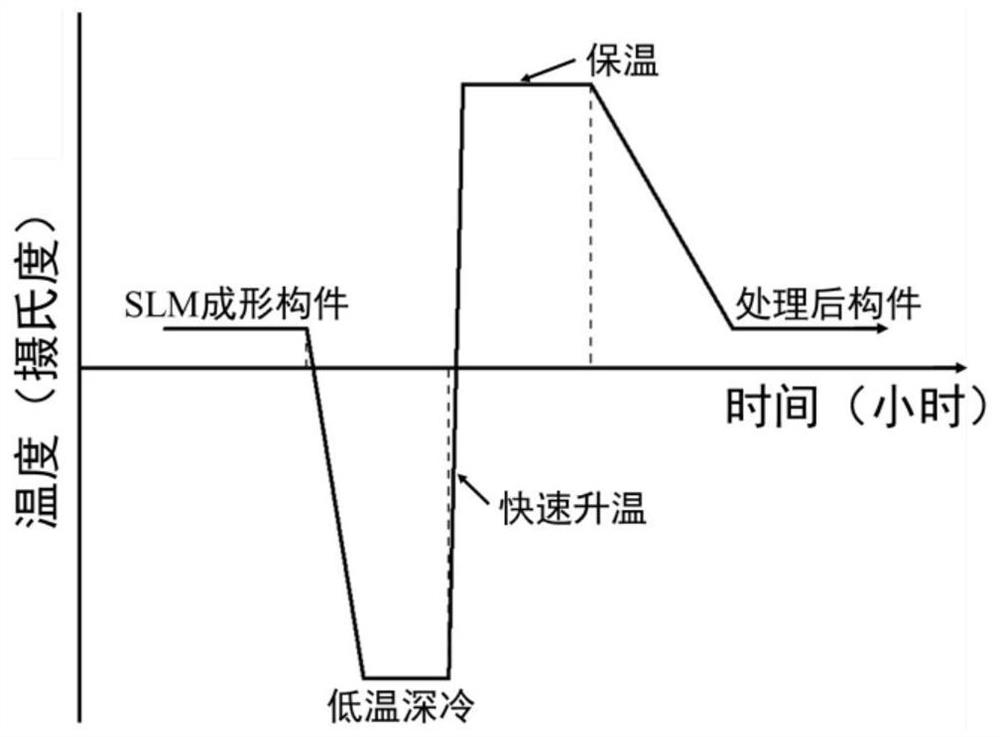Method for eliminating residual stress of aluminum alloy component formed by selective laser melting
A technology for selective laser melting and aluminum alloy components, applied in the field of material processing, can solve the problems of reduced material strength and inability to play a bearing role of structural components, and achieve the effect of ensuring mechanical properties
- Summary
- Abstract
- Description
- Claims
- Application Information
AI Technical Summary
Problems solved by technology
Method used
Image
Examples
Embodiment 1
[0026] This embodiment provides a method for eliminating residual stress of an aluminum alloy component formed by selective laser melting. In the method, a schematic diagram of the temperature of the component changing with time figure 1 shown; the specific steps are:
[0027] (S1) AlSi10Mg alloy components formed by selective laser melting are immersed in liquid nitrogen for 30 min;
[0028] (S2) the component is quickly transferred to 180 ℃ of dimethicone oil, so that it is rapidly heated up, and kept for 30min;
[0029] (S3) The take-out member is cooled to room temperature in the air.
[0030] Wherein, the transfer time in step S2 is 3s, and the average heating rate in this process is 52°C / min.
[0031] X-ray stress analyzer (equipment model: iXRD) was used to test the residual stress of the AlSi10Mg alloy components formed by selective laser melting before and after treatment. The stress is reduced to 36±4MPa.
Embodiment 2
[0033] The present embodiment provides a method for eliminating residual stress of an aluminum alloy component formed by selective laser melting. The specific steps are:
[0034] (S1) AlSi10Mg alloy components formed by selective laser melting are immersed in liquid nitrogen for 30 min;
[0035] (S2) the component is quickly transferred to 150 ℃ of dimethyl silicone oil, so that it is rapidly heated up, and kept for 30min;
[0036] (S3) take out the member and cool it to room temperature in air;
[0037] (S4) Repeat operations S1-S3 once.
[0038] Wherein, the transfer time in step S2 is 3s, and the average heating rate in this process is 38°C / min.
[0039] X-ray stress analyzer (equipment model: iXRD) was used to test the residual stress of the AlSi10Mg alloy components formed by selective laser melting before and after treatment. The stress is reduced to 10±3MPa.
Embodiment 3
[0041] The present embodiment provides a method for eliminating residual stress of an aluminum alloy component formed by selective laser melting. The specific steps are:
[0042] (S1) AlSi10Mg alloy components formed by selective laser melting are immersed in liquid nitrogen for 30 min;
[0043] (S2) quickly transfer this component to 150 ℃ of dimethyl silicone oil, make it heat up rapidly, and keep warm for 10min;
[0044] (S3) take out the member and cool it to room temperature in air;
[0045] (S4) Repeat operations S1-S3 twice.
[0046] Wherein, the transfer time in step S2 is 3s, and the average heating rate in this process is 36°C / min.
[0047] X-ray stress analyzer (equipment model: iXRD) was used to test the residual stress of the AlSi10Mg alloy components formed by selective laser melting before and after treatment. The stress is reduced to 26±4MPa.
PUM
 Login to View More
Login to View More Abstract
Description
Claims
Application Information
 Login to View More
Login to View More - R&D
- Intellectual Property
- Life Sciences
- Materials
- Tech Scout
- Unparalleled Data Quality
- Higher Quality Content
- 60% Fewer Hallucinations
Browse by: Latest US Patents, China's latest patents, Technical Efficacy Thesaurus, Application Domain, Technology Topic, Popular Technical Reports.
© 2025 PatSnap. All rights reserved.Legal|Privacy policy|Modern Slavery Act Transparency Statement|Sitemap|About US| Contact US: help@patsnap.com

